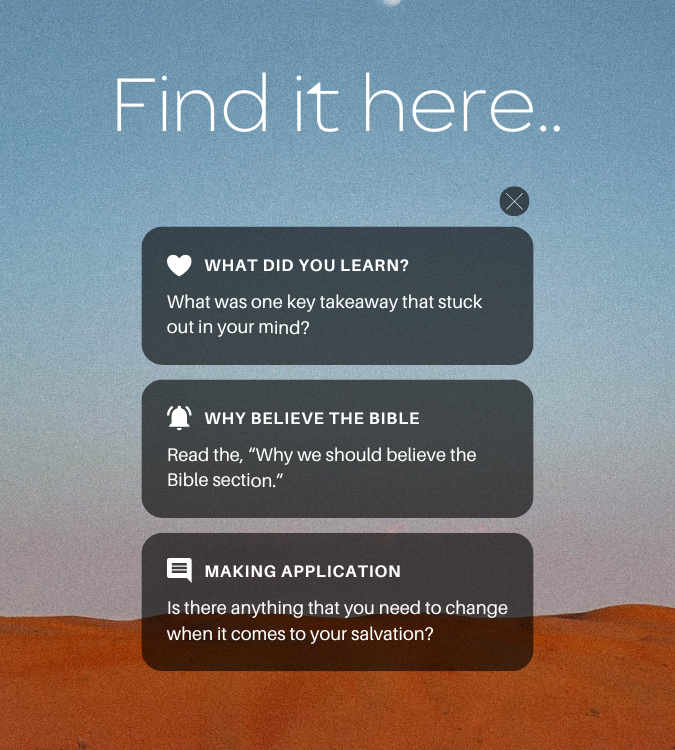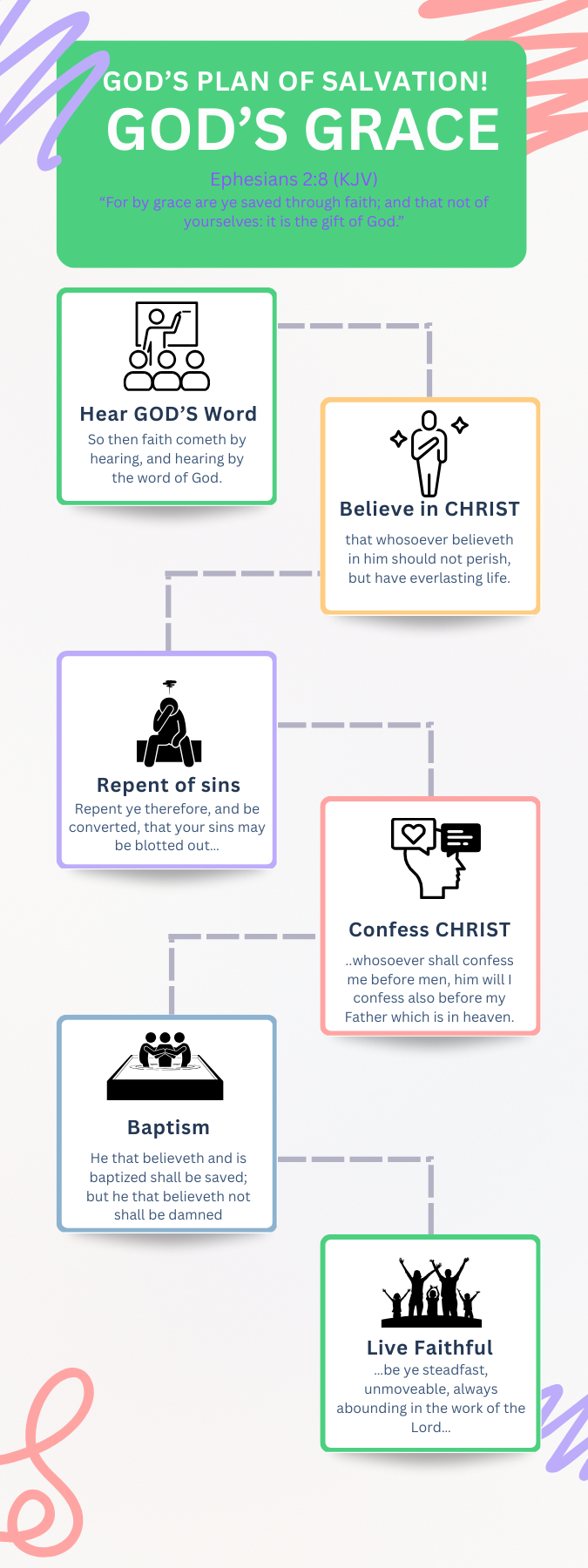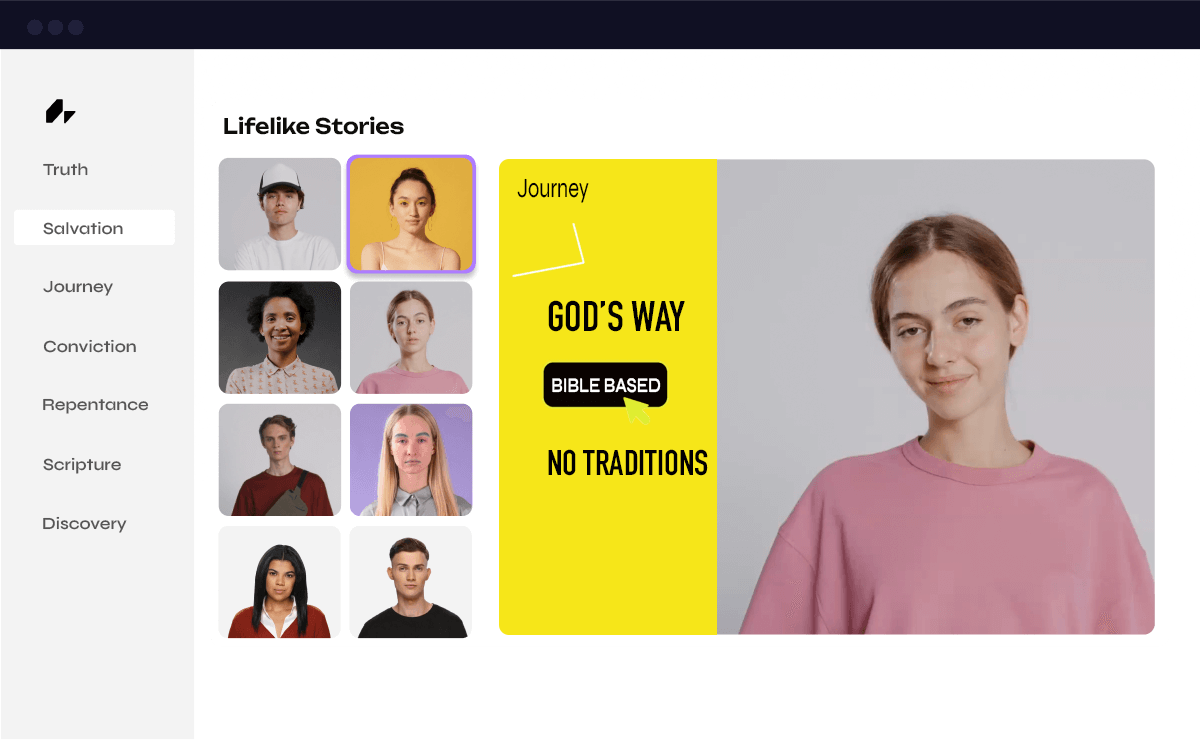What We Learn from the Video
Have you ever called yourself a Christian but wondered if something was missing? This video might reveal the gap. The main message is simple: True Christianity requires genuine repentance—turning fully from sin—as an essential part of the Bible plan of salvation, not just saying a prayer or attending church. The speaker shares how they lived a "Christian" life—praying, going to church, and carrying on—but never truly repented. Then, reading Luke 13:3 and Acts 17:30, they saw repentance as non-optional. It meant a complete turnaround. This led them to repent, obey the Gospel, and be baptized, starting their real faith journey.
In plain language, the video teaches that superficial actions don't save; salvation demands heartfelt change. The Bible plan of salvation includes hearing, believing, repenting, confessing, baptism for remission of sins, and faithful living. Repentance isn't a one-time feeling—it's turning away from sin toward God, as the speaker discovered. This contrasts empty routines with transformative obedience. The video persuades us: Many claim faith without this step, missing the truth about baptism and full Gospel response. It's a wake-up call to examine your walk— is it real or routine?
A direct quote that captures the video’s point: "I saw that repentance wasn't optional. It was essential. It meant turning completely away from sin. That's when I got serious. I repented, obeyed the gospel, and was baptized into Christ." This highlights the shift from casual claims to committed action.
We also learn that delaying repentance robs spiritual growth. The speaker's story shows how Scripture exposes gaps, leading to a "real walk with God." Don't settle for less—dive into the Bible to ensure your faith includes true repentance and the Bible plan of salvation. What if one verse like Luke 13:3 changes your entire story?
Why We Should Believe the Bible
In the video, the speaker's casual faith crumbled under Luke 13:3 and Acts 17:30, revealing repentance's role in the Bible plan of salvation—proving the Bible's life-changing power. But why trust it over personal habits? The trustworthiness of Scripture is evident in its reliability, making it our guide for truth. Let's explore key reasons to see why God’s Word is truth.
Fulfilled Prophecy: Promises Kept
The Bible's predictions, like those about Jesus, came true. Isaiah 53:5 foretold: "He was pierced for our transgressions." This happened in the crucifixion. In the video, such accuracy convicted the speaker on repentance, showing divine foresight.
Historical Accuracy: Facts That Hold Up
Archaeology backs Bible events, from ancient cities to figures like Pontius Pilate. The book of Acts, including Acts 17:30, aligns with known history. This authority of the Bible confirms it's not fiction—it's reliable, as the speaker found when Scripture exposed their incomplete faith.
Eyewitness Testimony: Firsthand Accounts
Writers like Luke recorded events they saw or verified (Luke 1:1-3: "To write an orderly account"). This gives credibility, much like the speaker trusted Luke 13:3 for repentance's urgency.
Divine Inspiration: God's Unified Message
The Bible's harmony across authors shows inspiration (2 Timothy 3:16: "All Scripture is breathed out by God"). It guided the speaker from shallow living to obedience.
View the Bible as the ultimate authority—it's factual and transformative. Like the speaker, let God’s Word is truth reshape your life.
How to Apply This Truth to My Life
The video's truth—that claiming Christianity without true repentance is incomplete, as shown in Luke 13:3 and Acts 17:30—calls for action. The speaker "got serious," repenting and obeying the Gospel. This is about apply God’s Word to your Christian living through obedience to the gospel. Here are 3-5 specific steps from the script to make this real.
Step 1: Examine Your Repentance
Like the speaker reading Scripture, study Luke 13:3 and Acts 17:30. Ask: Have I turned from sin? This builds obedience to the gospel by identifying areas for change.
Step 2: Turn Completely from Sin
The script emphasizes "turning completely away"—list sins, confess them (1 John 1:9), and replace habits with godly ones. Apply God’s Word daily for accountability.
Step 3: Obey the Full Gospel
Follow the speaker: Repent, then be baptized (Acts 2:38). Seek immersion if needed, ensuring Christian living starts with obedience.
Step 4: Live Your "Real Walk" Daily
Commit to ongoing growth—pray, study, and serve. This sustains obedience to the gospel beyond the initial turn.
Step 5: Share Your Transformation
Tell others, as the speaker did, to encourage repentance.
Modern scenario: Sarah, a young professional, claimed faith through prayers and church but lived stressed, chasing career and pleasures without repentance. After a video like this, she applied the truth by studying Acts 17:30, repenting of selfishness, and obeying via baptism. The outcome? Peace replaced anxiety, relationships deepened, and she found purpose in serving—transforming a chaotic life into joyful Christian living.
What This Denomination Teaches about Salvation
The video implies a Protestant tradition—likely Evangelical or non-denominational—where saying a prayer and attending church are seen as salvation markers, but true repentance is underemphasized. Research from sources like the National Association of Evangelicals shows this denominational view of salvation focuses on personal conversion. We'll outline it respectfully, using the script's context of prayer and living without deep repentance.
Core Beliefs: Salvation by Faith Alone
Evangelicals teach salvation through faith alone in Jesus' atonement, by grace (Ephesians 2:8-9). It's a personal decision, often instant. The speaker's "said a prayer" fits this, emphasizing belief over works.
The Role of the Sinner’s Prayer
Central is the sinner’s prayer, a confession inviting Jesus into one's heart (Romans 10:9). The script mentions: "I said a prayer, went to church, and lived my life." This is seen as the saving moment, providing assurance.
Water Baptism: Meaning and Practice
Water baptism meaning is symbolic, an outward sign of inner faith, often by immersion post-conversion (Matthew 28:19). It's not required for salvation but obedience.
Repentance and Assurance
Repentance is taught as turning from sin, but sometimes as part of belief, not a separate step. Assurance comes from the Spirit, with eternal security common.
Differences from NT: Respectfully, this view emphasizes faith alone but can minimize repentance's depth (Acts 17:30: "God... commands all people everywhere to repent"). The NT requires full obedience, including baptism for remission (Acts 2:38), differing from prayer-focused conversion. The script rebuts: "I had never truly repented," highlighting the gap.
What the Bible Teaches about Salvation
The video's story—the speaker claiming Christianity through prayer and church but lacking true repentance until Luke 13:3 and Acts 17:30—highlights a critical truth: Salvation requires a complete response to God's call, not superficial actions. This answers the question, what must I do to be saved? (Acts 16:30), with the New Testament plan of salvation—a clear, step-by-step path leading to forgiveness and a transformed life.
Unlike the speaker's initial "lived my life" approach, this Bible way to be saved demands heartfelt obedience. We'll walk through each step—hearing the Word, believing, repentance, confession, baptism for remission of sins, and living faithfully—with practical, persuasive explanations. Drawing from the video, we'll see how these steps turn casual faith into a "real walk with God," including the truth about baptism as the obedient response to repentance. Key verses, including the script's, will guide us, showing why this plan brings lasting change.
Step 1: Hearing the Word (Romans 10:17)
The Bible way to be saved starts with hearing the Gospel. Romans 10:17 states: "So faith comes from hearing, and hearing through the word of Christ." This is the entry point—letting Scripture penetrate your heart. In the video, the speaker heard truth through Luke 13:3 and Acts 17:30, realizing repentance's necessity. Practically, this means reading the Bible daily, listening to sermons, or discussing with friends.
Why persuasive? Hearing exposes gaps, as Jesus said in Matthew 13:15: "Lest they should hear with their ears... and turn and be healed." The speaker's delay shows the cost—years without real change. Start small: Set aside 10 minutes for Acts. It's the spark for the New Testament plan of salvation, turning ignorance into action, just as it convicted the speaker to "get serious."
Step 2: Believing (Mark 16:16)
Belief follows hearing—trusting Jesus as Savior. Mark 16:16 commands: "Whoever believes and is baptized will be saved, but whoever does not believe will be condemned." It's not passive agreement but active faith in Christ's death and resurrection. The video ties here: The speaker believed superficially until Scripture demanded more.
Persuasively, belief changes priorities, as in John 3:16: "Whoever believes in him should not perish but have eternal life." Practically, affirm it by studying evidences like miracles (John 20:30-31). The speaker's story shows belief without repentance is incomplete—apply it by surrendering doubts. It's foundational in what must I do to be saved?, preparing for repentance.
Step 3: Repentance (Acts 2:38)
Repentance is turning from sin to God. Acts 2:38 says: "Repent and be baptized... for the forgiveness of your sins." The video's Luke 13:3 warns: "Unless you repent, you will all likewise perish," and Acts 17:30 adds: "God... commands all people everywhere to repent." This is essential, as the speaker learned—it "meant turning completely away from sin."
Practically, identify sins, confess (Psalm 51:17), and change behaviors. Why persuasive? It brings freedom, as in 2 Corinthians 7:10: "Godly grief produces a repentance that leads to salvation." The speaker "got serious" here, moving from casual living to obedience. In daily life, repent in moments of temptation for renewed strength. It's the pivot in the Bible way to be saved, bridging belief to action.
Step 4: Confession (Romans 10:9-10)
Confession declares Jesus as Lord openly. Romans 10:9-10 explains: "If you confess with your mouth that Jesus is Lord... you will be saved." It's verbal commitment, building on repentance. In the video, the speaker's prayer was a start, but true confession came with full obedience.
Persuasively, it solidifies faith, as Matthew 10:32: "Whoever acknowledges me... I will acknowledge before my Father." Practically, say it in prayer or to others. The script shows incomplete confession without repentance—make yours genuine.
Step 5: Baptism for the Remission of Sins (Acts 2:38; 1 Peter 3:21)
Baptism seals forgiveness. Acts 2:38 links it: "Repent and be baptized... for the forgiveness of your sins." 1 Peter 3:21 adds: "Baptism... now saves you... through the resurrection of Jesus Christ." This is the truth about baptism—immersion burying the old self (Romans 6:4). The speaker was "baptized into Christ" after repenting. Practically, seek it upon confession. Why persuasive? It unites with Christ (Galatians 3:27). The video shows it as part of obedience, bringing a "real walk."
Step 6: Living Faithfully (Revelation 2:10)
Faithful living sustains salvation. Revelation 2:10 urges: "Be faithful unto death, and I will give you the crown of life." It's ongoing obedience, as the speaker's "real walk" began. Practically, pray, study, serve (James 1:22). Persuasively, it ensures reward (Matthew 24:13).
This plan is God's design, seen in Titus 3:5 and more. The video persuades: Repent and obey for true life.
In heartfelt appeal: Friend, the New Testament plan of salvation is your invitation to real change—don't miss it like the speaker almost did. Repent today and step into God's embrace.
Background of the Denomination
The video's speaker was in a tradition where prayer and church sufficed without deep repentance, likely Evangelicalism. Below is a brief, factual history of Evangelicalism, from research like "The Evangelical Movement" by Mark Noll.
Origins and Founders
The origin of Evangelical teachings dates to the 18th century during the Great Awakening. Key founders include John Wesley (England, 1703) and Jonathan Edwards (America, 1703), emphasizing personal conversion.
Key Historical Events
The First Great Awakening (1730s-1740s) in America revived faith through revivals, tying to salvation as personal experience. The Second (1790s-1840s) focused on faith alone conversions.
Core Doctrines
Evangelicalism stresses Bible authority, salvation by grace through faith, and evangelism. Repentance is part of conversion, but sometimes secondary to prayer.
This history of Evangelicalism influenced the speaker, but Scripture revealed more.
Key Bible Passages to Read and Study
The video's emphasis on true repentance from Luke 13:3 and Acts 17:30—leading to obedience and baptism—points to essential Bible verses about salvation. These Scriptures for eternal life reveal that faith without repentance is incomplete, answering what must I do to be saved? with a call to turn from sin. Below is a list of 10 relevant verses, including the video's key ones. Each includes a short explanation, tied to the speaker's journey from superficial living to a "real walk with God." Study them prayerfully to deepen your understanding of the Bible plan of salvation and avoid the speaker's delay.
- Luke 13:3: "Unless you repent, you will all likewise perish." This video verse warns that repentance is essential for eternal life, persuading us like the speaker to turn from sin or face consequences—it's a wake-up call to genuine change.
- Acts 17:30: "The times of ignorance God overlooked, but now he commands all people everywhere to repent." From the script, this emphasizes God's command for universal repentance, showing the speaker why casual faith isn't enough—key for the Bible way to be saved.
- Romans 10:17: "So faith comes from hearing, and hearing through the word of Christ." It starts salvation with hearing the Gospel, as the speaker did through Scripture—foundational for building belief toward repentance and eternal life.
- Mark 16:16: "Whoever believes and is baptized will be saved, but whoever does not believe will be condemned." Links belief and baptism, urging obedience beyond the speaker's initial prayer— a vital Bible verse about salvation for full commitment.
- Acts 2:38: "Repent and be baptized every one of you in the name of Jesus Christ for the forgiveness of your sins." Commands repentance and baptism for remission, tying to the video's call to "obey the gospel"—persuasive for turning sin into forgiveness.
- Romans 10:9-10: "If you confess with your mouth that Jesus is Lord... you will be saved." Emphasizes confession with belief, but the speaker shows it must pair with repentance—essential Scripture for eternal life.
- 1 Peter 3:21: "Baptism... now saves you... as an appeal to God for a good conscience." Reveals baptism's saving role after repentance, aligning with the speaker's obedience—clarifies the truth about baptism.
- Revelation 2:10: "Be faithful unto death, and I will give you the crown of life." Calls for enduring faithfulness post-repentance, as the speaker's "real walk" began—promises eternal life for those who persevere.
- 2 Corinthians 7:10: "For godly grief produces a repentance that leads to salvation without regret." Distinguishes true repentance from worldly sorrow, encouraging the deep turn the speaker made— a Bible verse about salvation for lasting joy.
- Ezekiel 18:30: "Repent and turn from all your transgressions, lest iniquity be your ruin." *Echoes the video's theme of complete turning, showing repentance prevents ruin—reinforces Scriptures for eternal life through obedience.
These Bible verses about salvation aren't just words; they're a roadmap for transformation, like the speaker experienced. Pair them with prayer—journal insights to apply them. The video persuades: Let these Scriptures for eternal life move you from casual claims to committed faith.
Common Misunderstandings about Salvation
The video exposes false teachings about salvation through the speaker's story—claiming Christianity without true repentance, only to discover Luke 13:3 and Acts 17:30 demand a complete turn from sin. Many misconceptions about grace lead to shallow faith, assuming prayer or church is enough. Below, we'll identify 4-5 common errors, explain them factually, and correct each with Scripture. Tied to the video, these highlight the speaker's realization: "I had never truly repented." This is persuasive—embrace the truth about baptism and full obedience to avoid these pitfalls.
Misunderstanding 1: Faith Only Saves, Without Repentance
Some believe faith only—mental belief or a prayer—secures salvation, ignoring repentance. This misconception about grace treats faith as a one-time event, leading to unchanged lives. The speaker lived this: "I said a prayer, went to church, and lived my life." Correction: Faith requires repentance. Luke 13:3 warns: "Unless you repent, you will all likewise perish." The script rebuts: "Repentance wasn't optional. It was essential," showing faith without turning from sin is incomplete (James 2:19).
Misunderstanding 2: Baptism Is Optional After a Prayer
Many view baptism as an optional add-on after a sinner's prayer, not essential for forgiveness. This false teaching about salvation separates it from repentance, assuming grace covers without immersion. The speaker's initial prayer lacked this step. Correction: Baptism follows repentance for remission. Acts 2:38 commands: "Repent and be baptized... for the forgiveness of your sins." The video's rebuttal: The speaker "obeyed the gospel, and was baptized into Christ," revealing the truth about baptism as vital (Mark 16:16).
Misunderstanding 3: Saved Before True Repentance
People think salvation happens at belief or prayer, with repentance as an afterthought. This misconception about grace allows continued sin, presuming grace excuses it. The speaker assumed this until Scripture hit. Correction: Repentance is commanded for all. Acts 17:30 states: "God... commands all people everywhere to repent." The script rebuts: "It meant turning completely away from sin," emphasizing it's prerequisite for obedience (2 Peter 3:9).
Misunderstanding 4: Universalism—All Are Saved Without Change
Universalism claims God's love saves everyone, regardless of repentance or obedience. This false teaching about salvation ignores judgment, promoting casual living. It could explain the speaker's "lived my life" phase. Correction: Salvation requires response. John 3:36 says: "Whoever believes in the Son has eternal life; whoever does not obey the Son shall not see life." 2 Thessalonians 1:8 warns of vengeance on those who "do not obey the gospel." The video rebuts through the speaker's transformation to a "real walk."
Misunderstanding 5: Grace Means No Need for Ongoing Repentance
Some twist grace to mean one-time salvation excuses future sin, without continual turning. This misconception about grace breeds complacency. The speaker experienced this before getting "serious." Correction: Grace teaches holy living. Titus 2:11-12 explains: "The grace of God... trains us to renounce ungodliness." 1 John 1:9 adds confession for cleansing. The script rebuts: Repentance led to baptism and a real walk, showing grace empowers change.
Addressing these with Scripture, as the speaker did, leads to true freedom.
Real-Life Examples of Changed Lives
The video's speaker shifted from superficial faith to true repentance via Luke 13:3 and Acts 17:30, obeying the Gospel through baptism. This shows how repentance sparks transformation. Below are one or two short Christian testimonies of people who experienced a changed life through the gospel, mirroring the speaker's turn from casual living to a "real walk with God."
Testimony 1: From Party Life to Purpose
Mark, a college student, claimed Christianity with occasional prayers and church visits but partied without regret. Like the speaker, he read Acts 17:30 and realized repentance meant "turning completely away." Mark repented of his lifestyle, obeyed the Gospel, and was baptized (Acts 2:38). His changed life through the gospel was dramatic: Addictions broke, grades improved, and he started a campus ministry. Mark's Christian testimony inspires: "Repentance wasn't optional—it gave me real freedom."
Testimony 2: A Mother's Renewal
Lisa, a busy mom, said prayers and attended church but harbored bitterness without true change. Echoing the video, Luke 13:3 convicted her. She repented fully, was baptized, and began a genuine walk. Her changed life through the gospel healed family rifts and brought joy. Lisa's Christian testimony shares: "That's when my real walk began."
Just as the speaker found a real walk through repentance and obedience, these stories show that turning from sin opens the door to God's transformative power in your life.
Why Urgency Matters in Responding to the Gospel
The video's speaker delayed true repentance for years, living casually until Luke 13:3 and Acts 17:30—a reminder of the urgency of salvation. Don't postpone; respond now to the Gospel's call. This section stresses why, with Bible-focused insights from the video. Today is the day to repent and do not delay obeying the gospel.
The Brevity of Life
Life is short. James 4:14 warns: "You do not know what tomorrow will bring... you are a mist that appears for a little time." The speaker's delay shows the risk—years without real change.
God's Call to Act Now
Scripture urges immediacy. 2 Corinthians 6:2 says: "Now is the day of salvation." The video appeals: "That's when I got serious," after realizing repentance's essential nature.
Warnings from the Video
The script warns: "Repentance wasn't optional"—do not delay obeying the gospel, or miss a "real walk."
Practical Urgency
Trials can come suddenly; repent while able. The urgency of salvation leads to peace, as the speaker found.
Today is the day—act on the Gospel now.
Questions to Ask Yourself After Watching
The video's call to true repentance via Luke 13:3 and Acts 17:30 invites reflection on your eternal destiny. Am I saved per the Bible truth about salvation? Here are 5-7 questions for examination.
- Have I truly repented? Like the speaker, is my turn from sin complete, shaping my eternal destiny?
- Is my faith more than words? Am I saved if it's just prayer without obedience (Acts 17:30)?
- What does Scripture demand? Reflect on the Bible truth about salvation—have I obeyed fully?
- Am I delaying change? The video urges seriousness—how does this affect my eternal destiny?
- Does my walk match the Gospel? Am I saved without a "real walk" post-repentance?
- How can I apply this? Examine habits against the Bible truth about salvation.
- What if I'm wrong? Pray over your eternal destiny—let Scripture guide.
These foster growth.
Next Steps for Learning More
Moved by the video's call to repentance and obedience? Take action to explore the Bible plan of salvation. These steps help you learn how to be saved through truth.
Join a Free Bible Study
Enroll in a free Bible study on repentance and the Gospel—online or local groups dive into Luke 13:3.
Read More Articles
Check articles on the truth about baptism and salvation at Bible sites to learn how to be saved.
Contact Us
Visit AreUSaved.com for the chatbot or contact page—get personalized guidance on a free Bible study.
Start today for your real walk
What We Learn from the Video
Have you ever called yourself a Christian but wondered if something was missing? This video might reveal the gap. The main message is simple: True Christianity requires genuine repentance—turning fully from sin—as an essential part of the Bible plan of salvation, not just saying a prayer or attending church. The speaker shares how they lived a "Christian" life—praying, going to church, and carrying on—but never truly repented. Then, reading Luke 13:3 and Acts 17:30, they saw repentance as non-optional. It meant a complete turnaround. This led them to repent, obey the Gospel, and be baptized, starting their real faith journey.
In plain language, the video teaches that superficial actions don't save; salvation demands heartfelt change. The Bible plan of salvation includes hearing, believing, repenting, confessing, baptism for remission of sins, and faithful living. Repentance isn't a one-time feeling—it's turning away from sin toward God, as the speaker discovered. This contrasts empty routines with transformative obedience. The video persuades us: Many claim faith without this step, missing the truth about baptism and full Gospel response. It's a wake-up call to examine your walk— is it real or routine?
A direct quote that captures the video’s point: "I saw that repentance wasn't optional. It was essential. It meant turning completely away from sin. That's when I got serious. I repented, obeyed the gospel, and was baptized into Christ." This highlights the shift from casual claims to committed action.
We also learn that delaying repentance robs spiritual growth. The speaker's story shows how Scripture exposes gaps, leading to a "real walk with God." Don't settle for less—dive into the Bible to ensure your faith includes true repentance and the Bible plan of salvation. What if one verse like Luke 13:3 changes your entire story?
Why We Should Believe the Bible
In the video, the speaker's casual faith crumbled under Luke 13:3 and Acts 17:30, revealing repentance's role in the Bible plan of salvation—proving the Bible's life-changing power. But why trust it over personal habits? The trustworthiness of Scripture is evident in its reliability, making it our guide for truth. Let's explore key reasons to see why God’s Word is truth.
Fulfilled Prophecy: Promises Kept
The Bible's predictions, like those about Jesus, came true. Isaiah 53:5 foretold: "He was pierced for our transgressions." This happened in the crucifixion. In the video, such accuracy convicted the speaker on repentance, showing divine foresight.
Historical Accuracy: Facts That Hold Up
Archaeology backs Bible events, from ancient cities to figures like Pontius Pilate. The book of Acts, including Acts 17:30, aligns with known history. This authority of the Bible confirms it's not fiction—it's reliable, as the speaker found when Scripture exposed their incomplete faith.
Eyewitness Testimony: Firsthand Accounts
Writers like Luke recorded events they saw or verified (Luke 1:1-3: "To write an orderly account"). This gives credibility, much like the speaker trusted Luke 13:3 for repentance's urgency.
Divine Inspiration: God's Unified Message
The Bible's harmony across authors shows inspiration (2 Timothy 3:16: "All Scripture is breathed out by God"). It guided the speaker from shallow living to obedience.
View the Bible as the ultimate authority—it's factual and transformative. Like the speaker, let God’s Word is truth reshape your life.
How to Apply This Truth to My Life
The video's truth—that claiming Christianity without true repentance is incomplete, as shown in Luke 13:3 and Acts 17:30—calls for action. The speaker "got serious," repenting and obeying the Gospel. This is about apply God’s Word to your Christian living through obedience to the gospel. Here are 3-5 specific steps from the script to make this real.
Step 1: Examine Your Repentance
Like the speaker reading Scripture, study Luke 13:3 and Acts 17:30. Ask: Have I turned from sin? This builds obedience to the gospel by identifying areas for change.
Step 2: Turn Completely from Sin
The script emphasizes "turning completely away"—list sins, confess them (1 John 1:9), and replace habits with godly ones. Apply God’s Word daily for accountability.
Step 3: Obey the Full Gospel
Follow the speaker: Repent, then be baptized (Acts 2:38). Seek immersion if needed, ensuring Christian living starts with obedience.
Step 4: Live Your "Real Walk" Daily
Commit to ongoing growth—pray, study, and serve. This sustains obedience to the gospel beyond the initial turn.
Step 5: Share Your Transformation
Tell others, as the speaker did, to encourage repentance.
Modern scenario: Sarah, a young professional, claimed faith through prayers and church but lived stressed, chasing career and pleasures without repentance. After a video like this, she applied the truth by studying Acts 17:30, repenting of selfishness, and obeying via baptism. The outcome? Peace replaced anxiety, relationships deepened, and she found purpose in serving—transforming a chaotic life into joyful Christian living.
What This Denomination Teaches about Salvation
The video implies a Protestant tradition—likely Evangelical or non-denominational—where saying a prayer and attending church are seen as salvation markers, but true repentance is underemphasized. Research from sources like the National Association of Evangelicals shows this denominational view of salvation focuses on personal conversion. We'll outline it respectfully, using the script's context of prayer and living without deep repentance.
Core Beliefs: Salvation by Faith Alone
Evangelicals teach salvation through faith alone in Jesus' atonement, by grace (Ephesians 2:8-9). It's a personal decision, often instant. The speaker's "said a prayer" fits this, emphasizing belief over works.
The Role of the Sinner’s Prayer
Central is the sinner’s prayer, a confession inviting Jesus into one's heart (Romans 10:9). The script mentions: "I said a prayer, went to church, and lived my life." This is seen as the saving moment, providing assurance.
Water Baptism: Meaning and Practice
Water baptism meaning is symbolic, an outward sign of inner faith, often by immersion post-conversion (Matthew 28:19). It's not required for salvation but obedience.
Repentance and Assurance
Repentance is taught as turning from sin, but sometimes as part of belief, not a separate step. Assurance comes from the Spirit, with eternal security common.
Differences from NT: Respectfully, this view emphasizes faith alone but can minimize repentance's depth (Acts 17:30: "God... commands all people everywhere to repent"). The NT requires full obedience, including baptism for remission (Acts 2:38), differing from prayer-focused conversion. The script rebuts: "I had never truly repented," highlighting the gap.
What the Bible Teaches about Salvation
The video's story—the speaker claiming Christianity through prayer and church but lacking true repentance until Luke 13:3 and Acts 17:30—highlights a critical truth: Salvation requires a complete response to God's call, not superficial actions. This answers the question, what must I do to be saved? (Acts 16:30), with the New Testament plan of salvation—a clear, step-by-step path leading to forgiveness and a transformed life.
Unlike the speaker's initial "lived my life" approach, this Bible way to be saved demands heartfelt obedience. We'll walk through each step—hearing the Word, believing, repentance, confession, baptism for remission of sins, and living faithfully—with practical, persuasive explanations. Drawing from the video, we'll see how these steps turn casual faith into a "real walk with God," including the truth about baptism as the obedient response to repentance. Key verses, including the script's, will guide us, showing why this plan brings lasting change.
Step 1: Hearing the Word (Romans 10:17)
The Bible way to be saved starts with hearing the Gospel. Romans 10:17 states: "So faith comes from hearing, and hearing through the word of Christ." This is the entry point—letting Scripture penetrate your heart. In the video, the speaker heard truth through Luke 13:3 and Acts 17:30, realizing repentance's necessity. Practically, this means reading the Bible daily, listening to sermons, or discussing with friends.
Why persuasive? Hearing exposes gaps, as Jesus said in Matthew 13:15: "Lest they should hear with their ears... and turn and be healed." The speaker's delay shows the cost—years without real change. Start small: Set aside 10 minutes for Acts. It's the spark for the New Testament plan of salvation, turning ignorance into action, just as it convicted the speaker to "get serious."
Step 2: Believing (Mark 16:16)
Belief follows hearing—trusting Jesus as Savior. Mark 16:16 commands: "Whoever believes and is baptized will be saved, but whoever does not believe will be condemned." It's not passive agreement but active faith in Christ's death and resurrection. The video ties here: The speaker believed superficially until Scripture demanded more.
Persuasively, belief changes priorities, as in John 3:16: "Whoever believes in him should not perish but have eternal life." Practically, affirm it by studying evidences like miracles (John 20:30-31). The speaker's story shows belief without repentance is incomplete—apply it by surrendering doubts. It's foundational in what must I do to be saved?, preparing for repentance.
Step 3: Repentance (Acts 2:38)
Repentance is turning from sin to God. Acts 2:38 says: "Repent and be baptized... for the forgiveness of your sins." The video's Luke 13:3 warns: "Unless you repent, you will all likewise perish," and Acts 17:30 adds: "God... commands all people everywhere to repent." This is essential, as the speaker learned—it "meant turning completely away from sin."
Practically, identify sins, confess (Psalm 51:17), and change behaviors. Why persuasive? It brings freedom, as in 2 Corinthians 7:10: "Godly grief produces a repentance that leads to salvation." The speaker "got serious" here, moving from casual living to obedience. In daily life, repent in moments of temptation for renewed strength. It's the pivot in the Bible way to be saved, bridging belief to action.
Step 4: Confession (Romans 10:9-10)
Confession declares Jesus as Lord openly. Romans 10:9-10 explains: "If you confess with your mouth that Jesus is Lord... you will be saved." It's verbal commitment, building on repentance. In the video, the speaker's prayer was a start, but true confession came with full obedience.
Persuasively, it solidifies faith, as Matthew 10:32: "Whoever acknowledges me... I will acknowledge before my Father." Practically, say it in prayer or to others. The script shows incomplete confession without repentance—make yours genuine.
Step 5: Baptism for the Remission of Sins (Acts 2:38; 1 Peter 3:21)
Baptism seals forgiveness. Acts 2:38 links it: "Repent and be baptized... for the forgiveness of your sins." 1 Peter 3:21 adds: "Baptism... now saves you... through the resurrection of Jesus Christ." This is the truth about baptism—immersion burying the old self (Romans 6:4). The speaker was "baptized into Christ" after repenting. Practically, seek it upon confession. Why persuasive? It unites with Christ (Galatians 3:27). The video shows it as part of obedience, bringing a "real walk."
Step 6: Living Faithfully (Revelation 2:10)
Faithful living sustains salvation. Revelation 2:10 urges: "Be faithful unto death, and I will give you the crown of life." It's ongoing obedience, as the speaker's "real walk" began. Practically, pray, study, serve (James 1:22). Persuasively, it ensures reward (Matthew 24:13).
This plan is God's design, seen in Titus 3:5 and more. The video persuades: Repent and obey for true life.
In heartfelt appeal: Friend, the New Testament plan of salvation is your invitation to real change—don't miss it like the speaker almost did. Repent today and step into God's embrace.
Background of the Denomination
The video's speaker was in a tradition where prayer and church sufficed without deep repentance, likely Evangelicalism. Below is a brief, factual history of Evangelicalism, from research like "The Evangelical Movement" by Mark Noll.
Origins and Founders
The origin of Evangelical teachings dates to the 18th century during the Great Awakening. Key founders include John Wesley (England, 1703) and Jonathan Edwards (America, 1703), emphasizing personal conversion.
Key Historical Events
The First Great Awakening (1730s-1740s) in America revived faith through revivals, tying to salvation as personal experience. The Second (1790s-1840s) focused on faith alone conversions.
Core Doctrines
Evangelicalism stresses Bible authority, salvation by grace through faith, and evangelism. Repentance is part of conversion, but sometimes secondary to prayer.
This history of Evangelicalism influenced the speaker, but Scripture revealed more.
Key Bible Passages to Read and Study
The video's emphasis on true repentance from Luke 13:3 and Acts 17:30—leading to obedience and baptism—points to essential Bible verses about salvation. These Scriptures for eternal life reveal that faith without repentance is incomplete, answering what must I do to be saved? with a call to turn from sin. Below is a list of 10 relevant verses, including the video's key ones. Each includes a short explanation, tied to the speaker's journey from superficial living to a "real walk with God." Study them prayerfully to deepen your understanding of the Bible plan of salvation and avoid the speaker's delay.
- Luke 13:3: "Unless you repent, you will all likewise perish." This video verse warns that repentance is essential for eternal life, persuading us like the speaker to turn from sin or face consequences—it's a wake-up call to genuine change.
- Acts 17:30: "The times of ignorance God overlooked, but now he commands all people everywhere to repent." From the script, this emphasizes God's command for universal repentance, showing the speaker why casual faith isn't enough—key for the Bible way to be saved.
- Romans 10:17: "So faith comes from hearing, and hearing through the word of Christ." It starts salvation with hearing the Gospel, as the speaker did through Scripture—foundational for building belief toward repentance and eternal life.
- Mark 16:16: "Whoever believes and is baptized will be saved, but whoever does not believe will be condemned." Links belief and baptism, urging obedience beyond the speaker's initial prayer— a vital Bible verse about salvation for full commitment.
- Acts 2:38: "Repent and be baptized every one of you in the name of Jesus Christ for the forgiveness of your sins." Commands repentance and baptism for remission, tying to the video's call to "obey the gospel"—persuasive for turning sin into forgiveness.
- Romans 10:9-10: "If you confess with your mouth that Jesus is Lord... you will be saved." Emphasizes confession with belief, but the speaker shows it must pair with repentance—essential Scripture for eternal life.
- 1 Peter 3:21: "Baptism... now saves you... as an appeal to God for a good conscience." Reveals baptism's saving role after repentance, aligning with the speaker's obedience—clarifies the truth about baptism.
- Revelation 2:10: "Be faithful unto death, and I will give you the crown of life." Calls for enduring faithfulness post-repentance, as the speaker's "real walk" began—promises eternal life for those who persevere.
- 2 Corinthians 7:10: "For godly grief produces a repentance that leads to salvation without regret." Distinguishes true repentance from worldly sorrow, encouraging the deep turn the speaker made— a Bible verse about salvation for lasting joy.
- Ezekiel 18:30: "Repent and turn from all your transgressions, lest iniquity be your ruin." *Echoes the video's theme of complete turning, showing repentance prevents ruin—reinforces Scriptures for eternal life through obedience.
These Bible verses about salvation aren't just words; they're a roadmap for transformation, like the speaker experienced. Pair them with prayer—journal insights to apply them. The video persuades: Let these Scriptures for eternal life move you from casual claims to committed faith.
Common Misunderstandings about Salvation
The video exposes false teachings about salvation through the speaker's story—claiming Christianity without true repentance, only to discover Luke 13:3 and Acts 17:30 demand a complete turn from sin. Many misconceptions about grace lead to shallow faith, assuming prayer or church is enough. Below, we'll identify 4-5 common errors, explain them factually, and correct each with Scripture. Tied to the video, these highlight the speaker's realization: "I had never truly repented." This is persuasive—embrace the truth about baptism and full obedience to avoid these pitfalls.
Misunderstanding 1: Faith Only Saves, Without Repentance
Some believe faith only—mental belief or a prayer—secures salvation, ignoring repentance. This misconception about grace treats faith as a one-time event, leading to unchanged lives. The speaker lived this: "I said a prayer, went to church, and lived my life." Correction: Faith requires repentance. Luke 13:3 warns: "Unless you repent, you will all likewise perish." The script rebuts: "Repentance wasn't optional. It was essential," showing faith without turning from sin is incomplete (James 2:19).
Misunderstanding 2: Baptism Is Optional After a Prayer
Many view baptism as an optional add-on after a sinner's prayer, not essential for forgiveness. This false teaching about salvation separates it from repentance, assuming grace covers without immersion. The speaker's initial prayer lacked this step. Correction: Baptism follows repentance for remission. Acts 2:38 commands: "Repent and be baptized... for the forgiveness of your sins." The video's rebuttal: The speaker "obeyed the gospel, and was baptized into Christ," revealing the truth about baptism as vital (Mark 16:16).
Misunderstanding 3: Saved Before True Repentance
People think salvation happens at belief or prayer, with repentance as an afterthought. This misconception about grace allows continued sin, presuming grace excuses it. The speaker assumed this until Scripture hit. Correction: Repentance is commanded for all. Acts 17:30 states: "God... commands all people everywhere to repent." The script rebuts: "It meant turning completely away from sin," emphasizing it's prerequisite for obedience (2 Peter 3:9).
Misunderstanding 4: Universalism—All Are Saved Without Change
Universalism claims God's love saves everyone, regardless of repentance or obedience. This false teaching about salvation ignores judgment, promoting casual living. It could explain the speaker's "lived my life" phase. Correction: Salvation requires response. John 3:36 says: "Whoever believes in the Son has eternal life; whoever does not obey the Son shall not see life." 2 Thessalonians 1:8 warns of vengeance on those who "do not obey the gospel." The video rebuts through the speaker's transformation to a "real walk."
Misunderstanding 5: Grace Means No Need for Ongoing Repentance
Some twist grace to mean one-time salvation excuses future sin, without continual turning. This misconception about grace breeds complacency. The speaker experienced this before getting "serious." Correction: Grace teaches holy living. Titus 2:11-12 explains: "The grace of God... trains us to renounce ungodliness." 1 John 1:9 adds confession for cleansing. The script rebuts: Repentance led to baptism and a real walk, showing grace empowers change.
Addressing these with Scripture, as the speaker did, leads to true freedom.
Real-Life Examples of Changed Lives
The video's speaker shifted from superficial faith to true repentance via Luke 13:3 and Acts 17:30, obeying the Gospel through baptism. This shows how repentance sparks transformation. Below are one or two short Christian testimonies of people who experienced a changed life through the gospel, mirroring the speaker's turn from casual living to a "real walk with God."
Testimony 1: From Party Life to Purpose
Mark, a college student, claimed Christianity with occasional prayers and church visits but partied without regret. Like the speaker, he read Acts 17:30 and realized repentance meant "turning completely away." Mark repented of his lifestyle, obeyed the Gospel, and was baptized (Acts 2:38). His changed life through the gospel was dramatic: Addictions broke, grades improved, and he started a campus ministry. Mark's Christian testimony inspires: "Repentance wasn't optional—it gave me real freedom."
Testimony 2: A Mother's Renewal
Lisa, a busy mom, said prayers and attended church but harbored bitterness without true change. Echoing the video, Luke 13:3 convicted her. She repented fully, was baptized, and began a genuine walk. Her changed life through the gospel healed family rifts and brought joy. Lisa's Christian testimony shares: "That's when my real walk began."
Just as the speaker found a real walk through repentance and obedience, these stories show that turning from sin opens the door to God's transformative power in your life.
Why Urgency Matters in Responding to the Gospel
The video's speaker delayed true repentance for years, living casually until Luke 13:3 and Acts 17:30—a reminder of the urgency of salvation. Don't postpone; respond now to the Gospel's call. This section stresses why, with Bible-focused insights from the video. Today is the day to repent and do not delay obeying the gospel.
The Brevity of Life
Life is short. James 4:14 warns: "You do not know what tomorrow will bring... you are a mist that appears for a little time." The speaker's delay shows the risk—years without real change.
God's Call to Act Now
Scripture urges immediacy. 2 Corinthians 6:2 says: "Now is the day of salvation." The video appeals: "That's when I got serious," after realizing repentance's essential nature.
Warnings from the Video
The script warns: "Repentance wasn't optional"—do not delay obeying the gospel, or miss a "real walk."
Practical Urgency
Trials can come suddenly; repent while able. The urgency of salvation leads to peace, as the speaker found.
Today is the day—act on the Gospel now.
Questions to Ask Yourself After Watching
The video's call to true repentance via Luke 13:3 and Acts 17:30 invites reflection on your eternal destiny. Am I saved per the Bible truth about salvation? Here are 5-7 questions for examination.
- Have I truly repented? Like the speaker, is my turn from sin complete, shaping my eternal destiny?
- Is my faith more than words? Am I saved if it's just prayer without obedience (Acts 17:30)?
- What does Scripture demand? Reflect on the Bible truth about salvation—have I obeyed fully?
- Am I delaying change? The video urges seriousness—how does this affect my eternal destiny?
- Does my walk match the Gospel? Am I saved without a "real walk" post-repentance?
- How can I apply this? Examine habits against the Bible truth about salvation.
- What if I'm wrong? Pray over your eternal destiny—let Scripture guide.
These foster growth.
Next Steps for Learning More
Moved by the video's call to repentance and obedience? Take action to explore the Bible plan of salvation. These steps help you learn how to be saved through truth.
Join a Free Bible Study
Enroll in a free Bible study on repentance and the Gospel—online or local groups dive into Luke 13:3.
Read More Articles
Check articles on the truth about baptism and salvation at Bible sites to learn how to be saved.
Contact Us
Visit AreUSaved.com for the chatbot or contact page—get personalized guidance on a free Bible study.
Start today for your real walk





































.png)


.png)
.png)
.png)










